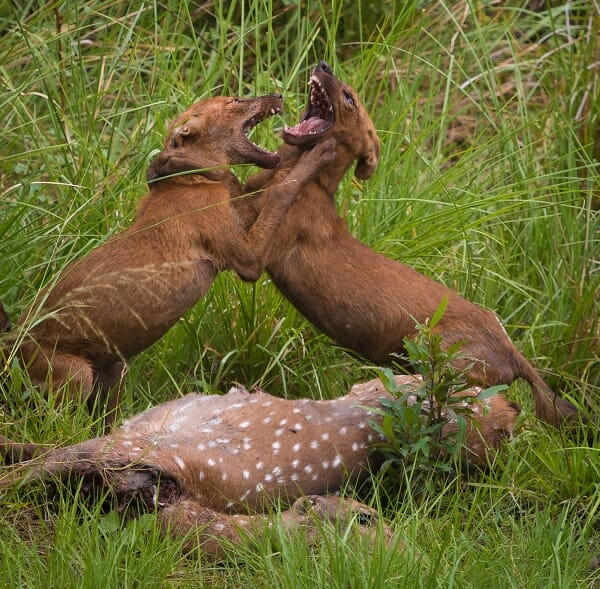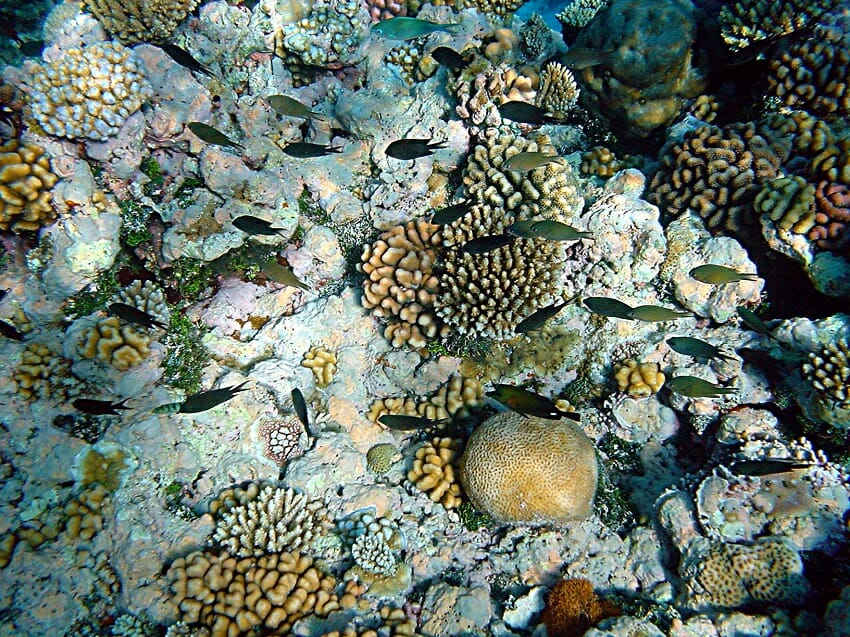Competition Definition in Biology
Competition is a relationship between organisms in which one is harmed when both are trying to use the same resource related to growth, reproduction, or survivability. Competition stems from the fact that resources are limited. There are simply not enough of some resources for all individuals to have equal access and supply. Competition can occur between organisms of the same species, or between members of different species.
Competition between species can either lead to the extinction of one of the species, or a decline in both of the species. However, this process can often be interrupted by environmental disturbances or evolution, which can change the rules of the game. Competition is often involved when species are limited in their range, often by direct competition from other organisms.
Examples of Competition
Intraspecific Competition
Intraspecific competition is a density-dependent form of competition. “Intra” refers to within a species, as opposed to “inter” which means between. Intraspecific competition can be summed up in the image below.

In this image, two wild dogs known as Dholes fight over a carcass. The carcass is a resource, something both organisms need to survive. Intraspecific competition is density dependent for one reason. The more dholes you have, the less food each one gets. To the individual dhole, food is everything. With very few predators of their own, the most successful dholes (the ones who survive and reproduce the most) often are simply the ones who eat the most.
Thus, while these dholes may have coordinated to take down this deer, they are now competing to see which one will get to eat first. The one that eats first will get more, and be more likely to survive and reproduce. The other one (or the last one if there are many) will not get as much. This will lower its survivability and the chances it will get to reproduce. Since evolution relies mainly on which organisms reproduce, this form of competition can quickly lead to changes in a population if only a few of the individuals are surviving and reproducing.
Interspecific Competition
Interspecific competition is between individuals which are different species. This could be between any two species, as long as they are competing over a resource. An interesting example of interspecific competition is found in coastal marine environments, like the coral reef in the picture below.
In this picture, there are dozens of species. There are several species of fish. Behind them, as a backdrop many people would ignore, is a canvas of dozens of species of coral. Coral, while it may look like some sort of rock or plant, is actually a colony of tiny animals. These tiny animals filter organic material from the water, and use stored bacteria to photosynthesize sunlight for additional energy. Thus, each coral species is competing with not only the other corals, but also with the fish for available nutrients and sunlight.
While corals might not seem like a competitive bunch, they are actually directly competitive with other corals. When an enemy coral is encroaching on their space, they can deploy chemical warfare to counter their rival. Often, coral fights end in one of the corals being killed by the other. While the corals are not predators of each other, the competition still ends in the death of one of the corals. The victorious coral was simply fighting for the resources it needs.
Direct and Indirect Competition
There is also another aspect of competition that can be applied to scenarios of limited resources, and that is the idea of direct vs indirect competition. Direct competition is like both of the scenarios above, and there are many more examples of it. Any time two or more animals fight or have a symbolized confrontation, this is probably some sort of competition for a resource.
However, indirect competition is when the two animals do not interact, but the presence of both animals in the same territory causes the competition. Think of the fish in the example above. If those fish feed on the same resources used by the corals, then the fish are in competition for the limited resources. Coral, being more or less anchored to the ocean floor, have little chance of directly attacking the fish. Instead, this would be referred to as an asymmetrical indirect competition. The fish eat as much of the food as they want, and the coral are limited to scraps. The coral have no way of competing. Luckily for most coral reef systems around the world, the ocean has plenty of food for most.
Outcomes of Competition
Competition is not a static process. Once set in motion, it can go a number of different ways. While the models may show that it will eventually drive one species to extinction, in reality a number of things can happen. First, an environmental disturbance, such as a fire or large wave, can upset the ecosystem and destroy the advantage the best competitor had. Typically, a pinewood forest is made mostly of pine trees because they are the best competitors in the environment. However, after a forest fire the most populous plants are small, opportunistic plants that grow quickly. The fire causes a change in the environment, which completely changes the dynamics of competition.
Further, most competition is also an evolutionary pressure on both parties. Animals from both sides that compete the best are able to survive and reproduce. Thus, over time the competition tends to resolve itself. More often than not, the competition can devolve as the species adapt to use different resources or change the way it uses a resource. This is known as character displacement. It is most well-documented in finches. When two different species of finch live on separate islands, their beaks are the same size because they prefer similar seeds. When they occupy the same island, one of their beaks gets smaller while the other gets larger. This separates the resources they consume and alleviates the competition.
Quiz
1. Which of the following represents competition?
A. Two swans (male and female) doing a mating dance
B. A lion defends its kill from a pack of hyenas
C. A lion stalks a buffalo, ready to pounce
2. What is the difference between intra- and interspecific competition?
A. Intraspecific is between members of the same species
B. Interspecific is between members of the same species
C. They are the same
3. A bald eagle is flying over a field, and sees a smaller hawk. The hawk has a fresh kill, but the bald eagle swoops in, threatens the hawk, and steals it. Which term best describes this scenario?
A. Predation
B. Intraspecific, indirect competition
C. Interspecific, direct competition
References
- Cain, M. L., Bowman, W. D., & Hacker, S. D. (2008). Ecology. Sunderland, MA: Sinauer Associates, Inc.
- Feldhamer, G. A., Drickamer, L. C., Vessey, S. H., Merritt, J. F., & Krajewski, C. (2007). Mammology: Adaptation, Diversity, Ecology (3rd ed.). Baltimore: The Johns Hopkins University Press.
- Kaiser, M. J., Attrill, M. J., Jennings, S., Thomas, D. N., Barnes, D. K., Brierley, A. S., & Hiddink, J. G. (2011). Marine Ecology: Processes, Systems, and Impacts. New York: Oxford University Press.

